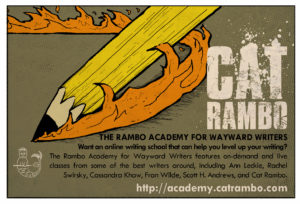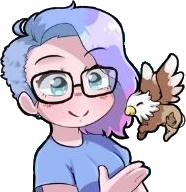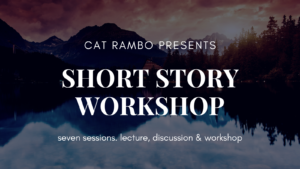 I started my little online writing school, the Rambo Academy for Wayward Writers, with the launch of Google Hangouts, which enabled me to host classes for people across the globe. Since then, Hangouts has declined, but the school continues strong, having hosted hundreds of students from around the world. Over a dozen of the best writers and teachers in the fantasy and science fiction field — with several new folks joining us in early 2019 — have led workshops on over three dozen topics.
I started my little online writing school, the Rambo Academy for Wayward Writers, with the launch of Google Hangouts, which enabled me to host classes for people across the globe. Since then, Hangouts has declined, but the school continues strong, having hosted hundreds of students from around the world. Over a dozen of the best writers and teachers in the fantasy and science fiction field — with several new folks joining us in early 2019 — have led workshops on over three dozen topics.
Perhaps the most rewarding thing about the school has been the network of friends it’s helped me build, with students joining on to score Nebula and Hugo awards and multiple publications, many moving into the F&SF world as editors and publishers as well. Another is that I get to sit in on classes by some amazing folks, which enriches my writing.
Looking back at my own bibliography, I have to laugh at how many flash or shorter pieces started as writing exercises for the classes that I did along with the students. And one of the things that amuses me most about the school is that it is partially responsible for Rachel Swirsky’s lovely, luminous, and somewhat notorious “If You Were a Dinosaur, My Love,” which she wrote when sitting in on the Literary Techniques for Genre Writers class.

When I started recruiting other writers to teach, I kept in mind the reason I had started teaching online in the first place — irritation with a local college, where I was teaching a six week workshop, and making $25 an hour there teaching a class whose participants were paying several hundred dollars to the college to take it. The philosophy of the Academy is that the bulk of the money should go to the teacher and that’s worked well, to the point where one teacher said recently that teaching for me had spoiled them for teaching unpaid convention workshops.
Another part of the school’s philosophy is paying things forward and making the class accessible to people who couldn’t otherwise afford by providing three free slots in each class (sometimes more). These are the Plunkett scholarships, named for the fantasy writer Lord Dunsany, aka Edward Plunkett. The only criteria for a Plunkett is that you want to take the class but can’t currently afford it, and people are welcome to apply multiple times. One class, Stories that Change The World, is 50% Plunkett slots. Teachers are not told which students are Plunkett recipients and are paid for those students as well.
 Nowadays I actively go out and recruit some instructors, looking for workshops that aren’t being given, deep dives into a specific area rather than a broad overview. Some great examples are Build a Better Monster with SCIENCE with Seanan McGuire or Ann Leckie’s To Space Opera and Beyond as well as some of my own workshops, like Punk U, which covers all the -punk variants like steampunk, cyberpunk, hopepunk, solarpunk, monkpunk, and more, or Stories That Change the World: Writing Fiction with Empathy, Hope, and Insight.
Nowadays I actively go out and recruit some instructors, looking for workshops that aren’t being given, deep dives into a specific area rather than a broad overview. Some great examples are Build a Better Monster with SCIENCE with Seanan McGuire or Ann Leckie’s To Space Opera and Beyond as well as some of my own workshops, like Punk U, which covers all the -punk variants like steampunk, cyberpunk, hopepunk, solarpunk, monkpunk, and more, or Stories That Change the World: Writing Fiction with Empathy, Hope, and Insight.
So what’s coming up in 2019 for the Academy?
- New live classes! People asked for a class on plotting novels, and I have set up one taught by Kay Kenyon, who I’ve co-taught with multiple times and is an engaging and talented teacher. I also just confirmed that Catherine Lundoff will be teaching live workshops In Flagrante Delicto: Writing Effective Sex Scenes and So You Want to Write an Anthology?
Other topics I’m talking with people about are workshops on writing superhero fiction, politics and worldbuilding in SF, and writing when short of time. - More on-demand classes! I’m currently working on an on-demand version of the Flash Fiction workshop and after that will do the Punk U class. Also working on turning the Sutter class into an on-demand version. I’ve developed a more consistent format that I’m happy with, a mix of video, text, and writing exercises.
- Transcripts for the video components and (possibly) subtitles. This is a big accessibility issue that has been bugging me for a while and I apologize for not having addressed it before.
- More activity on the school blog, including guest posts and interviews with faculty.
- We have to move away from Google Hangouts! Currently I’m exploring options and am probably going to go with Zoom.
- More use of the Youtube channel.
- Rambo Academy merch, because who doesn’t want a Rambo Academy for Wayward Writers hoodie?
2018 was a banner year for the school, in which it grew by leaps and bounds. I hope for the same in 2019, and invite you to join me on its journey!
#sfwapro




 This is the workshop I give every couple of years; I will not be giving it in 2023. There will be
This is the workshop I give every couple of years; I will not be giving it in 2023. There will be 